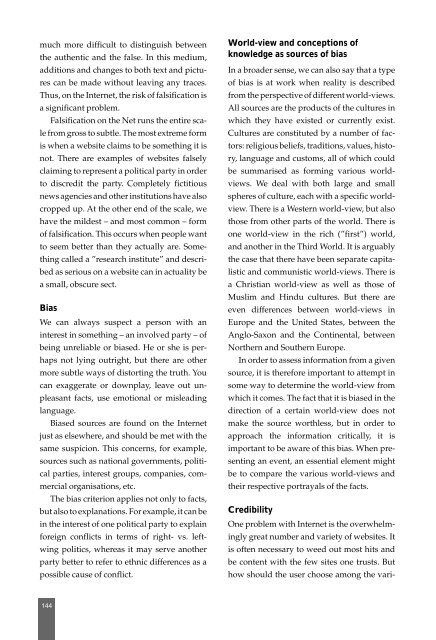Källkritik för Internet Källkritik för Internet
Källkritik för Internet Källkritik för Internet
Källkritik för Internet Källkritik för Internet
You also want an ePaper? Increase the reach of your titles
YUMPU automatically turns print PDFs into web optimized ePapers that Google loves.
much more difficult to distinguish between<br />
the authentic and the false. In this medium,<br />
additions and changes to both text and pictures<br />
can be made without leaving any traces.<br />
Thus, on the <strong>Internet</strong>, the risk of falsification is<br />
a significant problem.<br />
Falsification on the Net runs the entire scale<br />
from gross to subtle. The most extreme form<br />
is when a website claims to be something it is<br />
not. There are examples of websites falsely<br />
claiming to represent a political party in order<br />
to discredit the party. Completely fictitious<br />
news agencies and other institutions have also<br />
cropped up. At the other end of the scale, we<br />
have the mildest – and most common – form<br />
of falsification. This occurs when people want<br />
to seem better than they actually are. Something<br />
called a ”research institute” and described<br />
as serious on a website can in actuality be<br />
a small, obscure sect.<br />
Bias<br />
We can always suspect a person with an<br />
interest in something – an involved party – of<br />
being unreliable or biased. He or she is perhaps<br />
not lying outright, but there are other<br />
more subtle ways of distorting the truth. You<br />
can exaggerate or downplay, leave out unpleasant<br />
facts, use emotional or misleading<br />
language.<br />
Biased sources are found on the <strong>Internet</strong><br />
just as elsewhere, and should be met with the<br />
same suspicion. This concerns, for example,<br />
sources such as national governments, political<br />
parties, interest groups, companies, commercial<br />
organisations, etc.<br />
The bias criterion applies not only to facts,<br />
but also to explanations. For example, it can be<br />
in the interest of one political party to explain<br />
foreign conflicts in terms of right- vs. leftwing<br />
politics, whereas it may serve another<br />
party better to refer to ethnic differences as a<br />
possible cause of conflict.<br />
144<br />
World-view and conceptions of<br />
knowledge as sources of bias<br />
In a broader sense, we can also say that a type<br />
of bias is at work when reality is described<br />
from the perspective of different world-views.<br />
All sources are the products of the cultures in<br />
which they have existed or currently exist.<br />
Cultures are constituted by a number of factors:<br />
religious beliefs, traditions, values, history,<br />
language and customs, all of which could<br />
be summarised as forming various worldviews.<br />
We deal with both large and small<br />
spheres of culture, each with a specific worldview.<br />
There is a Western world-view, but also<br />
those from other parts of the world. There is<br />
one world-view in the rich (”first”) world,<br />
and another in the Third World. It is arguably<br />
the case that there have been separate capitalistic<br />
and communistic world-views. There is<br />
a Christian world-view as well as those of<br />
Muslim and Hindu cultures. But there are<br />
even differences between world-views in<br />
Europe and the United States, between the<br />
Anglo-Saxon and the Continental, between<br />
Northern and Southern Europe.<br />
In order to assess information from a given<br />
source, it is therefore important to attempt in<br />
some way to determine the world-view from<br />
which it comes. The fact that it is biased in the<br />
direction of a certain world-view does not<br />
make the source worthless, but in order to<br />
approach the information critically, it is<br />
important to be aware of this bias. When presenting<br />
an event, an essential element might<br />
be to compare the various world-views and<br />
their respective portrayals of the facts.<br />
Credibility<br />
One problem with <strong>Internet</strong> is the overwhelmingly<br />
great number and variety of websites. It<br />
is often necessary to weed out most hits and<br />
be content with the few sites one trusts. But<br />
how should the user choose among the vari-

















